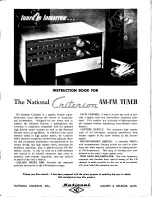
— 21 —
speech, and all-speech programming. An all-news station
might send:
MS=S
, but this would be very rare.
RDS Groups Received
(Menu Screen 17)
This screen will show a listing of the RDS data groups that
the station is transmitting. Groups are numbered zero to
15, with an A and a B version within each group.
Push and turn the knob
to scroll through the ac-
tive groups. The display
will show what percent-
age of RDS overhead re-
sources each group uses. The bulk of RDS functionality is
handled by just a few groups, others may be employed spo-
radically.
Only active groups will show on the list, but if an active
group’s usage drops to 0.0%, it will remain in the current list
until the list is reset. In this menu only, you may hold-down
the knob to manually clear groups from the list. Calculation
will start over when the knob is released.
RDS Alarm
(Menu Screens 18)
The INOmini 673 incorporates an alarm function associated
with the Radio Data System (RDS or RBDS). This flashing
alarm and rear-panel closure warns the user of one of two
alarm condition choices: 1) a missing 57kHz RDS subcarri-
er, or: 2) an incoming PI code that differs from the code
that the user can enter manually.
The default setting on
Menu Screen 18 is
Disa-
bled
. Push and turn the
knob and two alarm op-
tions may be selected:
RDS Loss
or
PI Error
.
When
RDS Loss
is selected, after a 10-second delay the loss
of the 57kHz RDS subcarrier will flash
RDS LOSS
on the
front panel and activate the rear-panel
R
terminal.
With
PI Error
alarm selection, the INOmini 673 gives an
alarm for a PI code mismatch between the received PI and a
PI code entered into the 673 by the user in Menu Screen 19.
— 22 —
After a 10-second delay, a PI mismatch will flash
PI CODE
on the LCD and activate the
R
terminal.
Refer to Pages 8 and 24 for using and programming the
R
terminal.
The RDS PI Setting
(Menu Screens 19)
When the INOmini 673 is programmed for a PI error alarm,
a valid PI code for the received station must be entered on
Menu Screen 19. You can verify the
PI code for your station on Menu
Screen 1 in the lower-left corner of
the LCD.
PI codes are hexadecimal values that use digits zero
through 9 and letters A through F. Although these ‘hex’
values are derived from call letters in North America, you
cannot simply enter call letters here.
On Menu Screen 19, push the knob and the first of four
character blocks will begin to blink. Turn the knob to select
the hexadecimal value
corresponding to the
first character of the sta-
tion’s PI code. Continue
this operation until you
have dialed-in the com-
plete 4-character PI code.
A final push will enter
the code into memory
and release the menu.
Audio High-Cut Filter
(Menu Screen 20)
The 673 receiver incorporates a user-selectable, rather gen-
tle low-pass filter to insert into the analog L/R and AES digi-
tal line outputs and the headphone monitor facility. This
filter allows the user to roll off the higher audio frequencies
at his discretion to re-
duce the audibility of
hiss-character noise un-
der poor reception con-
ditions.


































